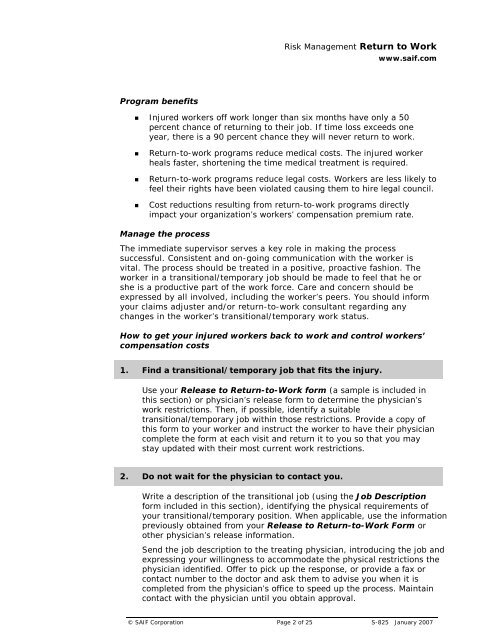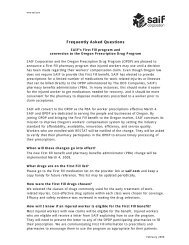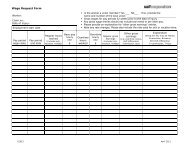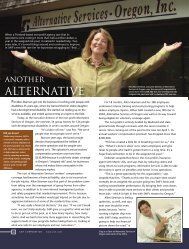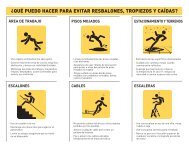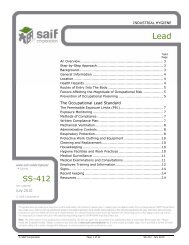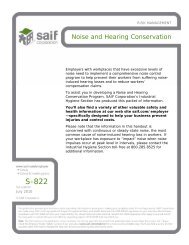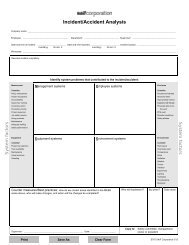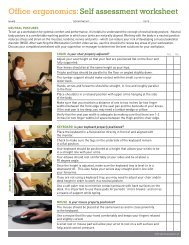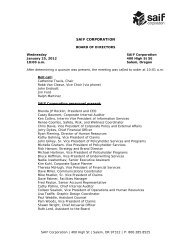Toolbox: Return-to-Work - SAIF Corporation
Toolbox: Return-to-Work - SAIF Corporation
Toolbox: Return-to-Work - SAIF Corporation
Create successful ePaper yourself
Turn your PDF publications into a flip-book with our unique Google optimized e-Paper software.
Risk Management <strong>Return</strong> <strong>to</strong> <strong>Work</strong><br />
www.saif.com<br />
Program benefits<br />
• Injured workers off work longer than six months have only a 50<br />
percent chance of returning <strong>to</strong> their job. If time loss exceeds one<br />
year, there is a 90 percent chance they will never return <strong>to</strong> work.<br />
• <strong>Return</strong>-<strong>to</strong>-work programs reduce medical costs. The injured worker<br />
heals faster, shortening the time medical treatment is required.<br />
• <strong>Return</strong>-<strong>to</strong>-work programs reduce legal costs. <strong>Work</strong>ers are less likely <strong>to</strong><br />
feel their rights have been violated causing them <strong>to</strong> hire legal council.<br />
• Cost reductions resulting from return-<strong>to</strong>-work programs directly<br />
impact your organization’s workers’ compensation premium rate.<br />
Manage the process<br />
The immediate supervisor serves a key role in making the process<br />
successful. Consistent and on-going communication with the worker is<br />
vital. The process should be treated in a positive, proactive fashion. The<br />
worker in a transitional/temporary job should be made <strong>to</strong> feel that he or<br />
she is a productive part of the work force. Care and concern should be<br />
expressed by all involved, including the worker’s peers. You should inform<br />
your claims adjuster and/or return-<strong>to</strong>-work consultant regarding any<br />
changes in the worker’s transitional/temporary work status.<br />
How <strong>to</strong> get your injured workers back <strong>to</strong> work and control workers’<br />
compensation costs<br />
1. Find a transitional/temporary job that fits the injury.<br />
Use your Release <strong>to</strong> <strong>Return</strong>-<strong>to</strong>-<strong>Work</strong> form (a sample is included in<br />
this section) or physician’s release form <strong>to</strong> determine the physician’s<br />
work restrictions. Then, if possible, identify a suitable<br />
transitional/temporary job within those restrictions. Provide a copy of<br />
this form <strong>to</strong> your worker and instruct the worker <strong>to</strong> have their physician<br />
complete the form at each visit and return it <strong>to</strong> you so that you may<br />
stay updated with their most current work restrictions.<br />
2. Do not wait for the physician <strong>to</strong> contact you.<br />
Write a description of the transitional job (using the Job Description<br />
form included in this section), identifying the physical requirements of<br />
your transitional/temporary position. When applicable, use the information<br />
previously obtained from your Release <strong>to</strong> <strong>Return</strong>-<strong>to</strong>-<strong>Work</strong> Form or<br />
other physician’s release information.<br />
Send the job description <strong>to</strong> the treating physician, introducing the job and<br />
expressing your willingness <strong>to</strong> accommodate the physical restrictions the<br />
physician identified. Offer <strong>to</strong> pick up the response, or provide a fax or<br />
contact number <strong>to</strong> the doc<strong>to</strong>r and ask them <strong>to</strong> advise you when it is<br />
completed from the physician’s office <strong>to</strong> speed up the process. Maintain<br />
contact with the physician until you obtain approval.<br />
© <strong>SAIF</strong> <strong>Corporation</strong> Page 2 of 25 S-825 January 2007


